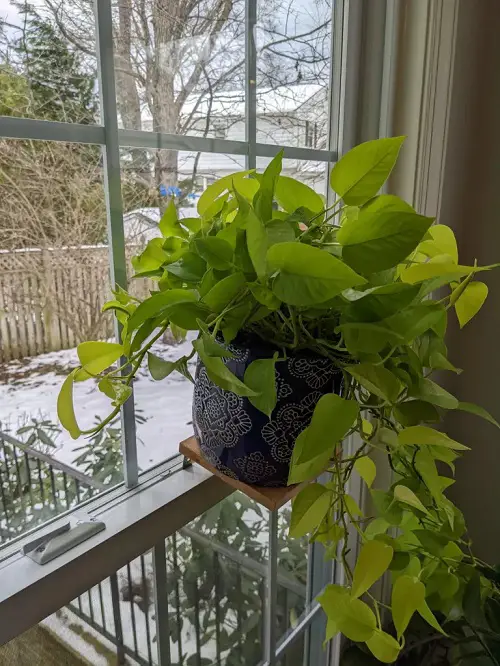Do you want to know How Cold Can Pothos Tolerate? Read this informative post to get all the right answers!

Pothos is a popular houseplant cherished for its lush, trailing vines and ability to thrive in a variety of indoor conditions. While these plants are generally recognized as hardy and resilient, they have certain temperature preferences and tolerances. So, How Cold Can Pothos Tolerate? Time to find out!
How Cold Can Pothos Tolerate?
While it is generally considered a tropical plant that thrives in warm conditions, it can tolerate lower temperatures to some extent. The safe temperature range for pothos depends on several factors, including the duration of exposure and the health and maturity of the plant.
In general, pothos can tolerate temperatures as low as 50°F (10°C) without significant damage. However, it is important to note that prolonged exposure to temperatures below 60°F (15°C) can negatively affect the plant’s growth and vitality.
Cold drafts and sudden temperature fluctuations should also be avoided, as they can cause stress and leaf drop.
Optimal Temperature Range for Pothos
The optimal temperature range for pothos (Epipremnum aureum) is generally between 65°F and 85°F (18°C to 29°C) to ensure the best foliage and growth. Within this range, pothos plants thrive and exhibit vigorous growth with lush, healthy foliage.
Temperatures within this optimal range provide the ideal conditions for photosynthesis, nutrient absorption, and metabolic processes in the plant. Pothos plants are tropical in origin, so they prefer warm and humid environments.
Warmer temperatures stimulate faster growth, encourage the development of new leaves, and promote overall plant vitality. However, it’s important to ensure adequate ventilation and airflow to prevent excessive heat and humidity, which can lead to issues such as fungal diseases or rot.
On the lower end of the optimal range, temperatures above 60°F (15°C) are generally tolerated well by pothos. Temperatures below this range, especially below 50°F (10°C), can slow down growth and potentially damage the plant.
Signs of Cold Damage in a Pothos Plant

- Leaf Discoloration: Cold-damaged pothos leaves may develop dark or blackened spots or patches. The discoloration may appear water-soaked or wilted, indicating cellular damage caused by freezing temperatures.
- Leaf Drooping: Cold-stressed pothos leaves may droop or wilt as a result of damage to the plant’s vascular system. This is a response to the compromised water uptake and transportation within the plant.
- Leaf Browning: Leaves exposed to cold temperatures may turn brown or develop brown edges. This discoloration occurs as a result of cell damage and can progress from the leaf tips inward.
- Stunted Growth: Cold-damaged pothos plants may exhibit slowed or stunted growth. The low temperatures can inhibit the plant’s metabolic processes, leading to reduced growth rates and smaller, less vigorous leaves.
- Leaf Drop: Severe cold damage can cause leaves to yellow and eventually drop from the plant. This is a protective response as the damaged leaves are shed to redirect resources toward new growth.
Check Best Pothos to Grow here
How to Revive Frost or Cold Damaged Pothos?
If your pothos plant has been damaged by frost and cold temperatures, there are steps you can take to help revive it. Here’s what you can do:
- Assess the Damage: Look for severely damaged or dead leaves that are unlikely to recover.
- Prune Damaged Foliage: Trim away any blackened or severely damaged leaves using clean, sharp pruning shears. This will allow the pothos to redirect its energy towards new growth.
- Provide Optimal Conditions: Move the pothos to a warm and well-lit area with temperatures within its preferred range (65°F to 85°F or 18°C to 29°C). Ensure the plant receives bright, indirect light but avoid placing it in direct sunlight, as the damaged foliage may be more sensitive to intense light.
- Adjust Watering: During the recovery period, adjust your watering routine to meet the plant’s needs. Keep the soil evenly moist but not soggy. Avoid overwatering, as cold-damaged roots may be more susceptible to rot. Allow the top inch or so of the soil to dry out before watering again.
- Humidity and Misting: Pothos plants appreciate moderate humidity. Increase humidity around the plant by placing a tray filled with water and pebbles nearby or by using a humidifier. You can also mist the remaining foliage occasionally to provide some extra moisture.
- Patience and Observation: Reviving a cold-damaged pothos takes time, and it may take several weeks or even months for new growth to emerge. Be patient and continue to provide optimal care. Monitor the plant closely for any signs of new growth and adjust your care routine accordingly.
Find 10 Best Tricks for Trailing Pothos here
Protecting Pothos from Cold Temperatures
- Shield from Cold Drafts: Position your pothos away from windows or doors where cold drafts can affect the plant. Cold air drafts can cause stress and damage to the foliage.
- Use Insulation: If your pothos is located in an area with colder temperatures, such as near windows or exterior walls, consider using insulation materials like bubble wrap or foam sheets to create a barrier between the plant and the cold surfaces. This helps to maintain a more stable temperature around the plant.
- Create a Microclimate: If your pothos is placed in a particularly cold room, create a microclimate by using a humidity tray filled with water and pebbles placed near the plant. The water evaporating from the tray increases humidity around the plant and creates a slightly warmer environment.
- Cover the Plant: During severe cold spells or frost warnings, you can cover your pothos with a light cloth or plant cover overnight. This provides an additional layer of insulation and protection against cold temperatures.


